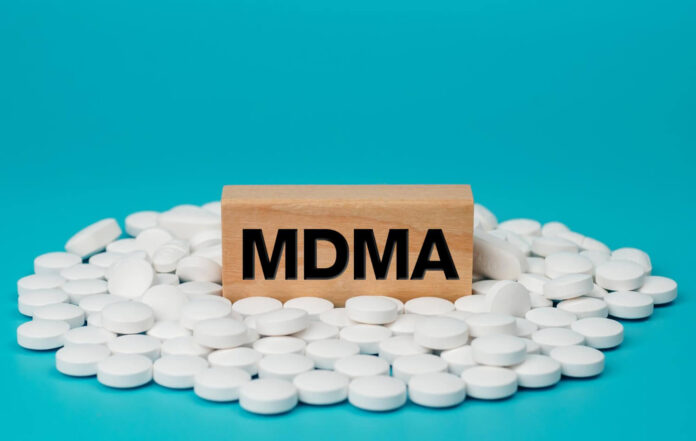MDMA is a popular synthetic drug that comes in a pill or powder form. It causes altered mood and perceptions, feelings of euphoria, loss of inhibitions, and an increase in energy, empathy, and pleasure. It is structurally similar to both methamphetamine and mescaline.
The most important factor in the safe use of MDMA is making sure that you have pure MDMA and that it does not include any toxic adulterants, an occurrence which is not uncommon.
What should MDMA look like? MDMA should be either in powder form and look like white or light gray crystals or as pills, which come in many colorful shapes, sometimes with different stamps on them. Though MDMA is ranked as the fourth least harmful drug in a recent harm assessment survey, many other drugs, some of which are highly toxic and appear identical, are often sold as MDMA. The only way to know if what you have is indeed MDMA, and not some other potentially toxic substance, is to test it. You can buy kits here if you are in the US or here if you are in the EU.
Read on to learn details about MDMA, the drugs it is often mixed with, known contraindications, and harm reduction habits to ensure safety when taking MDMA.
What is MDMA?
3,4-Methylenedioxymethamphetamine is the scientific name for the pure chemical compound known as MDMA. MDMA is a synthetic drug that is both a hallucinogen and a stimulant. The substance brings about feelings of self-confidence, euphoria, and peace. It is bitter to taste and has a chemical smell. MDMA is also commonly known as Molly and ecstasy.
- MDMA is called molly if it is in powdered form or in capsules. The powder might be white or gray crystals, and it is a widespread belief that Molly is a safe and pure form of MDMA.
- MDMA is called ecstasy if it is in tablet form. The pills are small and come in various colors and shapes. They will sometimes have pictures or letters stamped on them to identify the type of experience linked to the pill. For instance, a stamp of the letter ‘A’ on a yellow pill might mean it has amphetamine or acid in the pill.
There are also several other street names for MDMA, including the light-hearted monikers “disco biscuit”, “hug drug” and “lover’s speed”, as well as the more common names E, X, and XTC.
MDMA is not regulated therefore it is not uncommon for both powder or pill form to contain no MDMA at all, but instead other more dangerous drugs. The only way to know that what you are taking is MDMA is to test it. ALWAYS TEST BEFORE YOU CONSUME!
Contamination and MDMA
MDMA often includes fillers, some of which are dangerous drugs that mimic the effects of MDMA. Accidental deaths have been reported from taking other compounds presented as MDMA. MDMA is not dangerous by itself, but the adulterants and fillers added to the drug can be fatal.
Para-Methoxyamphetamine
One common contaminant of MDMA is para-Methoxyamphetamine (PMA). Adverse side effects of PMA include: irregular heartbeat, convulsions, confusion, and death. PMA causes a release of serotonin in the brain, but it prevents the body from reabsorbing the serotonin, which leads to adverse reactions. If you are taking medication that already impacts your serotonin levels, such as antidepressants, PMA is even more dangerous. Toxicity of PMA may occur at doses only slightly above the usual recreational dose and combining it with MDMA enhances its toxicity.
N-ethylpentylone
Another common substitute for MDMA is n-ethylpentylone, which comes from the cathinone (“bath salts”) group of stimulants. This stimulant has many of the same effects as MDMA, but they are not as pleasant.
- Physically, users experience high body temperature, convulsions, and rapid pulse.
- Psychological effects include psychosis, paranoia, and agitation.
- Also, there is a significant dosage difference between MDMA and n-ethylpentylone. With MDMA, the recommended dose is 100 milligrams, and n-ethylpentylone is only 30 milligrams. It is very easy to overdose.
N-methoxybenzy
N-methoxybenzy (NBOMe) is not a single drug but a class of drugs that have an N-methoxybenzyl group. They are in the same phenethylamines class of drugs as MDMA. Though 9 different variants have been described, three are listed as schedule 1 drugs: 25I-NBOMe, 25B-NBOMe, and 25C-NBOMe. 25I-NBOMe is often called synthetic acid because it binds to serotonin receptors in the same way LSD does. It is also often deceptively sold on blotter papers as LSD.
NBOMes have high potency compared to MDMA. A typical dose of MDMA is around 100-125mg, while a typical dose of 25I-NBOMe is only 0.5mg. NBOMe’s high potency, in combination with it being a common MDMA adulterant, increases the possibility of overdose. An overdose could result in anything from organ failure to cardiac arrest and death. NBOMes are known to have adverse effects on the cardiovascular system.
Click here for a complete list of common MDMA contaminants, and their potential effects.


